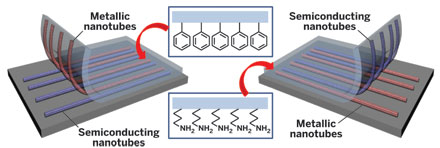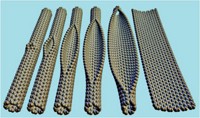Advertisement
Grab your lab coat. Let's get started
Welcome!
Welcome!
Create an account below to get 6 C&EN articles per month, receive newsletters and more - all free.
It seems this is your first time logging in online. Please enter the following information to continue.
As an ACS member you automatically get access to this site. All we need is few more details to create your reading experience.
Not you? Sign in with a different account.
Not you? Sign in with a different account.
ERROR 1
ERROR 1
ERROR 2
ERROR 2
ERROR 2
ERROR 2
ERROR 2
Password and Confirm password must match.
If you have an ACS member number, please enter it here so we can link this account to your membership. (optional)
ERROR 2
ACS values your privacy. By submitting your information, you are gaining access to C&EN and subscribing to our weekly newsletter. We use the information you provide to make your reading experience better, and we will never sell your data to third party members.
Materials
Sorting Nanotubes
Chemical coating winnows tiny carbon tubes by chirality
by Bethany Halford
July 7, 2008
| A version of this story appeared in
Volume 86, Issue 27

By functionalizing the surface of silicon, scientists at Stanford University and Samsung have devised a way to sort single-walled carbon nanotubes (SWNTs) according to their chirality (Science 2008, 321, 101). The method could help solve a long-standing problem in the fabrication of nanotube-based electronics.
Depending upon the spatial arrangement of its carbon atoms—its chirality—a SWNT can behave as either a metal or a semiconductor. Both types of tube are promising as electronic components, but they don't work well together. Unfortunately, SWNTs are produced as a mix of both chiralities. Although a number of methods can separate metallic and semiconducting SWNTs, none so far has proven practical for large-scale applications, according to Stanford chemical engineering professor Zhenan Bao.
In theory, metallic and semiconducting SWNTs should interact differently with certain functional groups. Bao and her research team reasoned they could simultaneously sort nanotubes by chirality and make thin-film transistors by adding functional group coatings to the surface of silicon substrates and then applying the SWNTs via spin coating. They found that semiconducting nanotubes preferentially cling to substrates with a coating of primary amines, while metallic SWNTs hold fast to substrates functionalized with phenyl groups. The spin coating process flings away the nonsticking type of nanotube.
From a typical SWNT blend, Bao's team was able to make transistors enriched with 90–95% of the nanotubes of desired chirality. "The method we've developed could be very useful for developing low-cost transparent electrodes for large-area displays and solar panels or as a means of sorting nanotubes for other applications," Bao says.
"This is a great contribution," comments Fotios Papadimitrakopoulos, a chemistry professor at the University of Connecticut who studies SWNTs. He notes that Bao's technique "provides an interesting venue for the directed assembly of carbon nanotubes for network thin-film transistors," but adds that a considerable amount of work still is required to realize the full potential of single-walled carbon nanotubes for electronic applications.





Join the conversation
Contact the reporter
Submit a Letter to the Editor for publication
Engage with us on Twitter